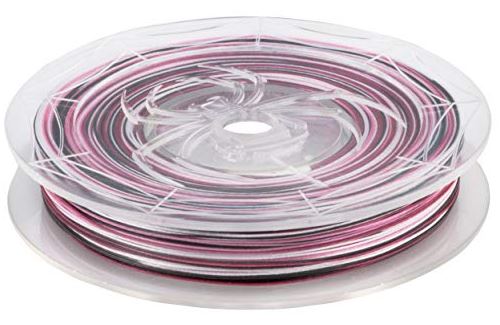Long before the appearance of one-strand vinyl fishing line, anglers would reel in their catches on braided line. The coming of monofilament meant that braided fishing line would spend some time in the shadows. Its days under the clouds, however, are definitely over. Braided line, as we know it today, is nothing like the woven fabric of yesteryear. In combination with other types of fishing line, braid also has more uses than it ever did before.
Follow along for a better understanding of braided fishing line. Learn how the different strand counts change the weave pattern, and how additives affect the line. Digest the physical properties of braided fishing line. And, finally, know the options for using braid in conjunction with monofilament and/or fluorocarbon.
The Ins & Outs Of Braided Fishing Line
Physical Properties Of Braided Fishing Line. What The Heck Is It? How Is It Different From Other Lines?
As avid anglers, we want to get right to the meat of the matter. But in the interest of those anglers that may just be joining the sport, it does more justice to start simple. Braided fishing line is exactly what the name suggests. It takes at least two separate strands of line to make a braid, though most lines use at least four. Adding more changes the weave, thus altering the outcome of the pattern.
Strong & Thin Means More Length On The Spool
Instead of the cotton and linen materials of old, braided fishing line now turns to strong man-made fibers to do the job. Dacron, Spectra, and micro-dyneema name a few of the new age materials. The end result of weaving two or more strands together remains the same in theory. It produces a stronger line at a much thinner diameter than mono or fluorocarbon lines. Anglers get a lot more yards on their reels using braided line.
Beware Of The No Stretch Reflex!
Stretch in braided fishing line is so small that it’s virtually unnoticeable, even at great distances. With braid, you could drop down 150 yards to a rock pile and still feel small nibbles.
A lack of stretch is a blessing when it comes to feeling the fish, but it takes some getting used to. Without any give, it’s easy for an angler to pull the hook through the set. Right out the fishes lip! Braid is also a pain to deal with if you get stuck on the bottom.
Limp Line Is Tough To Work With
Cue the salty sea dog jokes now. But all laughing matters aside, braided fishing line is limp when you compare it to lines with memory. Memory is that quality inherent in monofilament and fluorocarbon lines that makes them want to retain their shape. Bend them and they want to snap back. Some manufacturers treat their braid with a coating which results in a slight amount of memory. Otherwise, braid acts just like a thread in the hand.
Knicked Isn’t 100% Compromised
It’s true that PLine and other brands make monofilament that’s abrasion resistant. That being said, a good knick in monofilament or even fluorocarbon requires replacement. Not that it’s completely compromised, but any quick pull will likely cause it to snap.
This isn’t the case with braided fishing line, at least to a certain extent. Treatment or coating may add an abrasion resistant quality. Braided fishing line with lower strand counts is more easily compromised. Knicks are never good. Still, it’s better to lose 2 out of an 8 strand weave than 2 out of a 3 strand weave.
Does Braided Fishing Line Float?
Yes, it most certainly does! This is due to the fiber material common in the manufacturing of braided line. Some makers of braid add a heavier material that supposedly causes the line to sink. The great majority of anglers report that sinking braid doesn’t really sink. Saying it suspends would be a better term to use.
Durability Is An Up Front Cost
Anglers who refrain from using braided fishing line for financial reasons may be working to the contrary. Braid does tend to cost more per yard than monofilament line, but it also tends to last longer. This is usually the case on the spool and on the shelf. Many monofilament fishermen now back their spools with braided line for economic reasons alone. When it’s time to replace the mono they only replace part of the spool, so using less line.
With A Full Spectrum Of Colors, Does It Really Matter?
You might notice that braided fishing line comes in all different colors. Black, blue, white, purple, green, yellow, you name it. Braid comes in it. So which is better to use? Does it really matter? Opinions on the subject are plenty and they vary from angler to angler. It seems we can agree on a couple of points.
- When the fish are hungry enough. most any color will work.
- A 4′ – 8′ length of fluorocarbon works well when fish are line shy.
Treatments & Coatings To Braided Fishing Line
Spray on treatments that you can apply yourself can help keep your braid in top condition. Besides the conditioners, many braided lines come treated or coated with a chemical finish. With so many different brands and varieties on the market, be sure to pay attention to the details. Some treatments change the feel of the line, give a slight memory, and make it easier (or tougher) to handle.
Strand Count In Braided Fishing Line
Besides color, anglers must decide the amount of line to purchase as well as the test rating. These numbers are easy to find by examining your reel specifications. Just as important as length and test, is the strand count of your braided fishing line. Most manufacturers offer either 4, 6, or 8 strand spools. 16 strand lengths are also available, though the cost tends to raise with strand count incrementally.
You may deduce from logic alone that more strands equate to a stronger braid. You are correct in this assumption, but there is more to it than strength alone. The more strands that appear in a weave of braided fishing line, the rounder and smoother it becomes. This means the line has less friction through rod eyelets and is more resistant to abrasion. It’s also more durable.
Best Uses For Braided Line
Despite the fact that most braided lines cost more than monofilament, many anglers prefer it on their reels. Braid comes in handy in situations that call for finesse because you’ll feel the slightest of nibbles. This also holds true when fishing at greater depths. The stretch in monofilament lines can make it tough to feel the action.
An obvious reason to use braided fishing line is for its strength. Its thin diameter is just as powerful of a motive for use. Spooling up with braid can add hundreds of yards over monofilament. Yards you may desperately need when you hook into a large offshore specimen.
Last but not least, braid works well together with both mono and fluoro line. Although using fluorocarbon as a disappearing leader doesn’t always work, there are times when it’s all that will get the fish to bite. For those of you who prefer the feel of monofilament, consider backing with braided line. It’s an expense saver in the long run, and it’ll give you a good shot of extra distance. Just in case you hook a beast that wants to run.
Parting Tips
If you’re already using braided fishing line, you know that experience is the best teacher. For those thinking about making the switch, consider the points in this article. If you do decide to try braided line, here are a few final tips to aid in the transition.
- Invest in a pair of small scissors. Angle edged pliers and clippers often fail to trim braided line.
- Practice your knots. Both in your line to hook and line to line connections. The Palomar, Improved Clinch, Uni to Uni, and FG knots all come with high recommendations.
- Loosen up on your drag and avoid a dramatic hook set. Both habits will help reduce the frequency of pulled hooks.
- Be aware when spooling your reel. Some spools are braid ready while others will slip. Use a small backing of monofilament on spools that aren’t braid prepared.
- Consider using rods with superior line guides. Braided fishing line is tough and will wear on softer materials.
- Be careful using braided line. Avoid wrapping it around fingers or hands. With enough force, it can cut right through flesh and bone. But it can also cut through kelp and maybe save that tangled bass.
Hopefully, some gem of info stands out for you in the article above. Please don’t hesitate to ask questions, name your favorite brand, or add some knowledge using the comment box below. Tight lines until next time. FishtFight.com.

